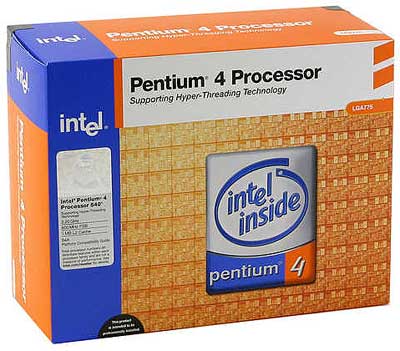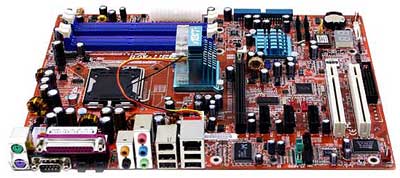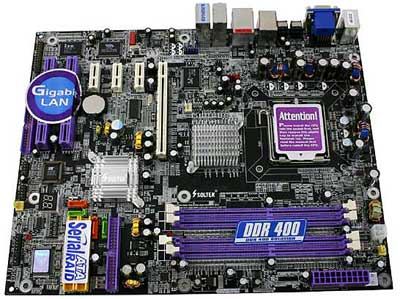Buyer's Guide - Mid-Range, October 2004
by Jarred Walton on October 21, 2004 11:00 AM EST- Posted in
- Guides
Intel CPU and Motherboard Recommendations
"Content Creation", in a generic sense, can still be said to favor Intel CPUs (yes, it is debatable), and so we recommend a Pentium 4 platform for that sort of work. There are also those who will insist on an Intel platform regardless of the overall performance, and we are willing to help them out with some recommendations. Just don't try to make the argument that Intel is more "reliable" as that is difficult to prove. The fact of the matter is that while Intel may not have the best architecture these days, they still have an advantage in other areas such as compiler technology. This can help them to maintain a lead in heavily optimized applications. They also have SSE3 support, which is not yet offered by AMD processors, and HyperThreading can actually help a system to feel more responsive when multitasking.If you're simply going with Intel because that's what you've always used and you assume that they are "better", take a good, long look at the numbers in our recent FX-55/4000+ article. It sums up the situation nicely:
"Closing up our video encoding tests, while AMD does win some, with appropriate optimizations in place Intel seems to be the right candidate here."The same applies for other applications as well: if you're using the latest versions of many professional applications - Photoshop CS, Premier CS, Illustrator CS, 3D Studio Max 7, etc. - you're more likely to benefit from Intel specific optimizations. We mentioned that Intel has better compiler technology than AMD, and that comes into play here. If you depend on an application that has extensive Intel optimizations, then Intel is the right choice. Overall, however, AMD definitely holds the performance crown for the majority of applications.
Then again, we're looking at benchmarks, and benchmarks are rarely the same as real world usage. In the real world, the majority of the CPU processing power is spent waiting for user input - e.g. while you type in Word, or edit an image in Photoshop, or read an article in Firefox. Unless you push your system to the limit on a regular basis, the difference between most of the fastest processors is really quite minor. An exotic car that can run at over 200 MPH is still going to be slow when driving around the neighborhood at 25 MPH. Most people tend to use their computers as commuter cars rather than racing around on the Autobahn. Whatever your reason for opting for an Intel platform, they do provide plenty of performance, and you're not likely to actually notice a difference in typical day-to-day use.

Socket 775 CPU: Pentium 4 540 3.2 GHz 1MB Cache
Price: $216 Shipped (Retail)
Coming with a price similar to the AMD CPUs that we selected, the Pentium 4 540 hits the "sweet spot" for CPU cost in a mid-range system. The Prescott core does run a lot hotter than other CPUs, but the retail HSFs on Intel boxed CPUs are more than capable of cooling the processors. The performance is about the same as the venerable 3.2C socket 478 CPU, which was the speed king and cost well over $400 one year ago, so it's difficult to complain about the bang for the buck. The P4 550 is also an option if you're willing to spend $50 more, but the 560 is simply too expensive for the minor performance increase that it brings over the 540 and 550. You could also opt to save $40 by going with the P4 530, as only those who run benchmarks for a living are likely to notice the loss of 200 MHz. All of the Pentium 4 socket 775 chips that bear the new model numbers come with HyperThreading, and we recommend that you leave it enabled. It may not provide a huge performance increase in typical use, and you might lose a few percentage points in some benchmarks, but it does help performance for other applications if you're running complex tasks in the background, e.g. video/audio encoding or 3D rendering.

Socket 775 Motherboard Recommendation: Abit AG8 i915P Chipset
Price: $129 Shipped
Our recommendation for a Pentium 4 motherboard is also comparable in price and features to the AMD motherboards. It comes with support for up to three Firewire ports, four SATA devices, and eight USB 2.0 devices. It also includes Intel's new High Definition Audio and PCI Express slots. These are all features that are nice to have, and prices have now dropped enough that there is not any real disadvantage in going with the new Intel platform. All of this comes with a motherboard from a manufacturer that is highly respected in the computing industry.
One decision that we made in order to save on costs was to stick with a motherboard that has four DDR1 DIMM slots as opposed to a DDR2 configuration. Our testing to date has not shown any advantage to DDR2 other than lower power consumption, and this is not likely to change until we start seeing Intel systems with the 1066 FSB. Part of the reason for this is that DDR2 simply has worse latencies than DDR1, and there are not many applications that actually require the bandwidth that DDR2-533 and faster RAM can provide. DDR2 RAM also carries a price premium - even the cheapest DDR2 PC4200 will run $250 for 2x512MB, while more expensive DIMMs can push the cost of 2x512MB well over $350. Good quality PC3200 DDR RAM can be had for less money and will typically match or beat the performance of DDR2.

Socket 775 Motherboard IGP Alternative: SOLTEK SL-915GPro-FGR i915G Chipset
Price: $144 Shipped
Users who do not demand a lot from their graphics subsystem might also take a look at some of the motherboards that use the 915G chipset. The latest Intel Graphics Media Accelerator 900 still lags far behind even entry level cards in gaming performance, but for non-gaming use, it is more than enough. It is also almost "free" when you consider the price of the otherwise similar i915P motherboards. The SOLTEK SL-915GPro-FGR that we show here comes with features similar to the Abit AG8 and adds the GMA-900 IGP. If you change your mind and decide that you want to add a PCI Express graphics card in the future, then that option is always there. Users who are not interested in Gaming or other 3D applications will probably never notice the loss of a discreet graphics card.










54 Comments
View All Comments
Confusednewbie1552 - Saturday, October 23, 2004 - link
Great, I've had my computer for 2 months and have been only using it for only a month and already it becomes mid-range. =( I was expecting it to last until at least by spring of 2005Degrador - Saturday, October 23, 2004 - link
I know the graphics issue has been mentioned in these comments already, but I just thought I'd add my 2 cents. A gaming article sounds like a great idea, but many people out there looking for a good computer want an all-in-one system. Especially for family buyers, they'll want systems that can do anything, whether it be office work / home business / kids schoolwork / games / burning CDs & DVDs / web surfing / etc. As such, the alternatives are really really great this time, as they give details and reasons for why people should change to other parts. However, I still think you should have included an option for a faster graphics card. You've given alternatives a high end 300GB 16MB cache HD, as well as the (debateably) higher end Raptor, along with high end RAM, and a separate sound card and good speakers, yet no alternative for even a modestly good AGP graphics card (let's be honest, the 9600 Pro is rather mediocre for the games and cards out there these days). I'm certainly not suggesting a 9800 Pro should be the primary graphics recommendation, but perhaps at least an alternative (or even X600 / 6800).Other than that, great guide :)
JarredWalton - Saturday, October 23, 2004 - link
Wow! The 90nm parts are "hot" - not in terms of temperature but in terms of demand. They'll come back down soon enough. Hell, at $266 not counting the cost of an aftermarket HSF you might as well get the 130 nm 3500+ retail. Monarch Computers is still saying $215 and $179 for the 3200+ and 3000+ parts, respectively, but they are out of stock until ~Oct. 29. Patience may be required if you don't want to spend more than $200. I think the suggested price of the 3200+ was $199 originally, but demand has pushed that up quite a bit.AlphaFox - Friday, October 22, 2004 - link
A64 3200+ 90nm 939 is now $266!!! I dont get how it went up $75 in the past 2 days!JarredWalton - Friday, October 22, 2004 - link
A few quick comments:Seagate vs. Samsung: As far as I can tell, they're about the same. Yes, Seagate comes with a 5 year vs. 3 year warranty. I've got both, and neither one has given me cause for complaint. Which is "better"? I call it a tie, and since I went with Seagate last time, I decided to toss in a Samsung this time. As the article states, Samsung, WD, Seagate, Maxtor, and Hitachi all make very similar drives. "Reliability" when you're talking about mostly new versions is almost impossible to guess.
NEC vs. Pioneer: Hacked firmware is not necessary, and the drive performs extremely well. There should be a review up sometime soon.
Prices for the Real Time Pricing Engine seem to be having some issues, so double check them. As for the Mushkin RAM listed in the article, it is not the "Blue" line but an older version. Newegg has it for $75 a DIMM (as of the time of writing).
#37: You can have a bad example of any company out there. I've had ASUS and Abit boards in the past that I had to RMA. Does one bad experience make the company untrustworthy? I don't think so, and I continue to use Abit and ASUS boards. For socket 939, the selection is very limited, and we've had good results with the MSI Neo2 Platinum. YMMV, of course. I'm not sure why you even bothered with MSI. If the boards was DOA, Newegg will replace it with no hassle in our experience. It takes an extra two weeks or so, unfortunately.
#34 brings up an interesting argument. If you actually went out and bought the same hardware that goes into a Dell or other OEM system, the price would be a lot lower than what is listed here. Don't even get me started on reliability and warranty concerns. The price of OEM systems appears attractive, but in the end you get what you pay for. DIY PC builders will always get better performance and reliability for the money. Obviously, that's not an option for Apple computers.
RandomCoil - Friday, October 22, 2004 - link
As with post #33, I don't understand the switch from Seagate to Samsung. The Seagate should be sufficiently fast for this system and the 5-year warranty and quiet operation are significant pluses.sophus - Friday, October 22, 2004 - link
i think the RAM was underpriced (and i realize things might have changed since publication):Mushkin Blue Line 184 Pin 512MB DDR PC-3200 - Retail
clicking the link above (and choosing newegg.com) -> $103 ...need 2 so $206
mushkin.com -> $227
this leads to a difference (approx) of $50 to $75. $200-225 compared to original listed price of $150.
i wanted to be all over 1GB for $150 but was unable to find the price 8(
Bugler - Friday, October 22, 2004 - link
You say that the Neo2 939 board has one problem, that being the difficulty removing larger graphics cards. Their bigger problem is unreliability.For months I followed your recommendations for MSI but after the 754 DFI came out, I delayed my purchase awaiting a 939 DFI board. The past week I got tired of waiting for DFI and went ahead and purchased the MSI 939 board.
The damn thing is dead on arrival. In addition, I emailed their tech support before they opened this morning. No response. Newegg had me call MSI. After being put on the call hold dialer for about five minutes, the machine finally said they were hanging up and that I should leave my contact number for tech support to call me back.
However, they never did. Screw MSI---RMA to new egg.
tolerant - Friday, October 22, 2004 - link
There are a bunch of 128mb sapphire 9600 pro's on newegg, including an opengl 2.0 bulk card, and an opengl 2.0 retail card. I recently ordered both the 2.0 bulk and retail cards, and instead of being 400 core/300 mem as expected, they ran at 391 core/229 mem. I'm not sure if I had two defective cards, but they got sent back. The price seemed too good to be true when I purchased, and I believe that $108 is a little low too, so if you order this path, make sure you get a 400/300 card.AlphaFox - Friday, October 22, 2004 - link
It should be noted that the prices for 90nm CPUs is wacked out: the 3200+ 939 90nm is now $246 and the 3000+ is $215. they have been going UP in the past week; im glad I got my 3200 for $191 a few days ago!